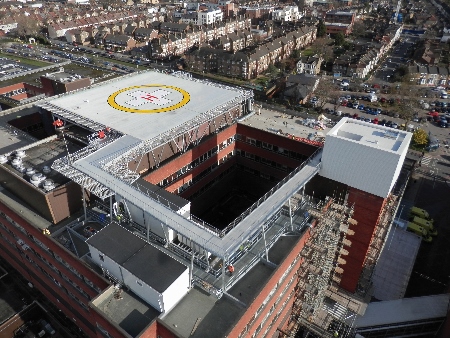Since the first helicopter ambulance was established in 1987, the service has expanded to cover most of the UK. As a large majority of major acute hospital developments now include helipad provision, we look at how design is key
Every second counts when dealing with serious injuries, and the first hour after any incident is critical.
Dr David Sutton, a consultant at University Hospital Southampton NHS Foundation Trust, explains: "When the clock starts ticking off the minutes of the 'Golden Hour', the difference between life and death is often a fast-flying helicopter that reaches the ill or injured sooner and gets back to A&E quickly enough to give those in distress the best-possible chance of survival.”
But, while there are helicopters and hospitals, what is missing are helipads. “In an emergency, when any delay can be deadly, being able to land seconds away from help will save lives,” says Dr Sutton.
The Helicopter Emergency Landing Pads Appeal (HELP) is part of an ongoing programme to raise the millions of pounds needed to construct or update existing helipads around the country and ensure that all major trauma centres and key A&E hospitals have suitable helipad access in the future.
Day and night
The charity has already raised money to fund facilities at Oswestry Spinal Injuries Unit, Southampton General Hospital, St George’s Hospital in London, Bristol Royal Infirmary, Southmeads Hospital in Bristol, and St Mary’s Hospital on the Isle of Wight, and is providing additional cash to refurbish and upgrade helipads at Gloucestershire Royal Hospital, Addenbrooke’s Hospital in Cambridge, Shrewsbury Hospital, Telford Hospital, and the Royal Preston Hospital.
When the clock starts ticking off the minutes of the 'Golden Hour', the difference between life and death is often a fast-flying helicopter
The design of these landing points is covered by Health Building Note 15-03 Hospital Helipads.
It provides guidance on everything from location, planning considerations, public safety, access, and licensing, as well as noise mitigation.
It states: “Helicopter ambulance operations are likely to increase and to extend their operations from day into night.
“As a result, hospital helipads have become an integral part of the pre-hospital care service and an important facility at many hospitals.
“This guidance aims to enable trust executives and staff to become informed customers when developing a business case and when managing the design, construction, and operation of a helipad.”
It outlines three main options for siting a helipad - at ground level, on a rooftop, or on a low structure or mound within the immediate area. All options require airways that are free of obstacles such as trees or high buildings, as well as a clear landing area. This is often hardest to find at ground level, although this approach is usually the cheapest to build and operate.
Helipads built on rooftops, ideally above the A&E unit to ensure a short transit for patients, are the most-effective choice from an aviation and strategic planning perspective. They largely remove any constraints on future building plans, provide the greatest choice of obstacle-free airways, and reduce the environmental impact on the hospital itself and its neighbours.
Speed counts
The last option – building on a mound or other low structure – has some of the benefits of a roof-top site, but costs less to construct and run.
Usually each helipad needs to have space for just one helicopter at a time, although some major trauma centres may need a second location in the case of multiple casualties.
The guidance also looks at drainage; the lifts, ramps or stairways via which patients are transferred from the helicopter to A&E units; the necessary medical equipment; and considerations such as lighting, storage, refuelling, ventilation, and fire safety.
Birmingham’s Queen Elizabeth Hospital opened its helipad in the summer of 2008. It is situated on the roof of a multi-storey carpark close to the emergency department.
Constructed to Civil Aviation Authority guidelines, patients are taken from the helicopter and lifted onto specially-designed gurneys, which are brought to ground level via a dedicated lift. They are then wheeled straight into the casualty unit.
Last year Miller Construction also completed a £5m facility at St George’s Hospital in London. Designed by Medical Architecture, it is the first to open south of the River Thames.
Miles Scott, chief executive of St George’s Healthcare NHS Trust, said: “As a major trauma centre, St George’s Hospital treats patients suffering from life-threatening injuries and illnesses. We know that getting our patients to us in the fastest time possible, so they can receive expert treatment, is vital for ensuring the best survival rates and future quality of life. The helipad is an important and impressive addition to the hospital.”
And Innerdale Hudson Architects and Studio 4 were instrumental in the design of landing sites at Eastbourne District General Hospital and Southampton General Hospital respectively. The latter has been designed to be relocated to the roof of the new East Wing Annexe at some point in the future.
A spokesman for Innerdale Hudson Architects said: “The helipad enables patients requiring urgent treatment to be transferred to and from the hospital more rapidly and makes the hospital the most-accessible landing site for air ambulance and other emergency helicopters of any hospital in Sussex.
“The new pad has also enhanced poor weather and night-time lighting, including landing lights and an illuminated wind sock.”

The new Bristol Southmeads Hospital is one of the latest to get a helipad as part of the HELP Appeal. Others include St George’s Hospital in London




